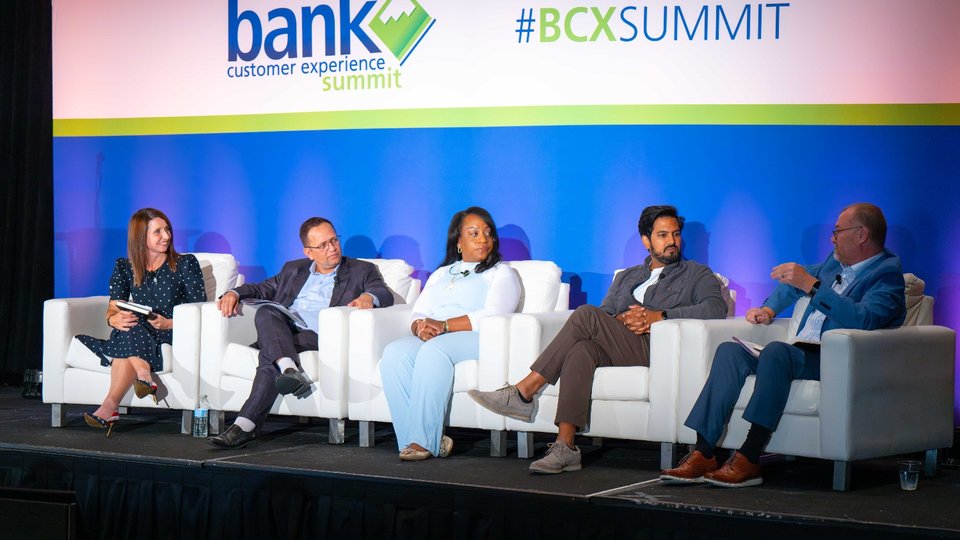Bank Customer Experience (BCX) Summit
Creating the best retail banking experience
A panel at the Bank Customer Experience Summit held in Charlotte, North Carolina from Sept. 9 to 11 did a deep dive into ideas and innovation for retail banking.

October 4, 2024 by Bradley Cooper — Editor, ATM Marketplace & Food Truck Operator
Retail banking remains a cornerstone of the modern bank strategy, even with the rise of new digital banking tools. But there are many ideas on how to develop the most impactful branch space, while still keeping a good customer experience and training employees. A panel at the Bank Customer Experience Summit hosted by Networld Media Group in Charlotte, North Carolina from Sept. 9 to 11, did a deep dive into ideas and innovation for retail banking.
Declan McCormack, client leader at BHDP moderated the panel with Michelle Kile, VP of branch services at Digital Federal Credit Union, Prakash Paudel, head of transaction banking sales and business at Global IME Bank, Vikas Srivastava, VP design lead at Fifth Third Bank and Marsha Womack, first VP and director of retail banking at Citizens Trust Bank.
Changes in retail banking
Srivastata said that a lot has changed significantly in the last 25 years. They have moved from transactional spaces to smaller spaces where a banker would greet a customer a guide them to the banking service they need. But the challenge is how to take what used to be a "hub for writing checks" and transform it.
Womach said that the way customers transact with each other has changed. "You don't have to have a bank account to send your friend money. There's a difference between transactions and our banking relationship."
Kile said that 20 years ago she read an article that the branch was dead. That is obviously not the case, but some banks have made the choice not to have branches. "You need to have a robust answer on why the branch is viable."
Redesigns
One major trend has been removing teller lines and creating universal banker experiences to guide customers to the advice and guidance they need. However, the panelists emphasized the importance of creating environments that are conducive to offering advice.
"You have to create the spaces for people to be advised and be comfortable," Srivastata said.
"You still need ability to help people with transactions," Womack said. On the advice side, you need to empower people so they can get from point A to point B and get the services they need at the branch.
Paudel said his bank learned to shift services during COVID by paying attention to how other countries such as the U.S. were handling the pandemic.
The data behind the "why"
However, how can banks get employees on board with these new retail banking strategies? Kile said you need to give them the "why" behind the strategy, which she uses data to demonstrate.
"In JD Power's 2024 Retail Banking survey, they found 42% of respondents received financial wellness from their institution," Kile said. When she asked the audience how many of those respondents acted upon that data, none guessed how high the number actually was, which was 76%.
The employees "may think they're planting all those seeds and that doesn't mean anything, but it does," Kile said.
Looking at a practical example, Srivastata spoke about how Fifth Third Bank created an innovative branch at an airport that removed teller lines and added pods where customers can interact with employees. In addition, the bank uses an interactive display overhead that customers walk through into the branch with more displays inside to draw them in.
"We don't have to do same security measures since it's in an airport," he said.
Practical strategies
However, not every bank has the ability to renovate older branches or create new ones due to cost considerations.
"We don't have hundreds of thousands of dollars to renovate these branches," Kile said. As a result, banks have to train employees to deliver the universal banking experience while working with traditional architecture such as teller lines.
"You have to a train employees how to do warm transfers from teller line to other bankers. That kind of choreography takes training. We don't have the luxury to be able to tear down those teller lines and put in pods," Kile said.
When asked what their ideal banking experience would be, Kile said that she wants there to be a seamless banking experience. When a customer walks in, the bank will know their most recent transaction and whether they had any issues with their banking services. For example, if the customer was on hold with the bank about a loan, the employee can mention that and ask if she needs help. In addition, the advertisements in the bank can be tailored to the individual, on the kiosk and digital signage screens.
Womack said that while this view may be a bit utopian, ultimately any successful banking experience is about building and maintaining relationships.
Paudel agreed with this point saying, "It's all about trust, less banks and more banking!" In other words, don't focus as much on the bank itself but rather how those banking services are being delivered to customers.









